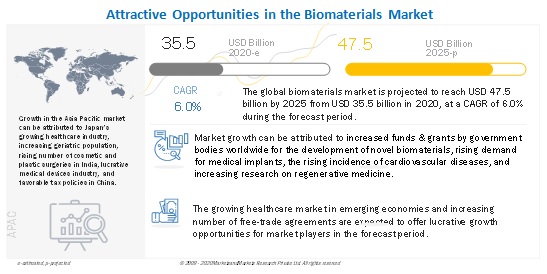
What This Report Will Provide?
This study involved four major activities in estimating the current size of the biomaterials market. Exhaustive secondary research was carried out to collect information on the market, its peer markets, and its parent market.
The next step was to validate these findings, assumptions, and sizing with industry experts across the value chain through primary research. Both top-down and bottom-up approaches were employed to estimate the complete market size.
Expected Revenue Growth:
[298 Pages Report] The global biomaterials market size is projected to reach USD 47.5 billion by 2025 from USD 35.5 billion in 2020, at a CAGR of 6.0% during the forecast period.
Major Growth Boosters:
Market growth is driven mainly by factors such as the increased funds & grants by government bodies worldwide for the development of novel biomaterials, rising demand for medical implants, and the rising incidence of cardiovascular diseases, increasing research on regenerative medicine.
In addition, high growth is expected for plastic surgery and wound healing applications, which will further drive the growth of the biomaterials market in the coming years.
COVID-19 impact on the biomaterials market :
COVID-19 is an infectious disease caused by the most recently discovered novel coronavirus. Largely unknown before the outbreak began in Wuhan (CHINA) in December 2019, COVID-19 has moved from a regional crisis to a global pandemic. With the World Health Organization (WHO) officially declaring the outbreak of COVID-19 a pandemic, a mix of established pharmaceutical and biopharmaceutical companies, as well as small startups, have stepped forward to develop treatments and vaccines that target the infection caused by the novel coronavirus.
Download PDF Brochure: https://www.marketsandmarkets.com/pdfdownloadNew.asp?id=393
Recent Developments :
- In 2019, Royal DSM (Netherlands) and ProMed Pharma (US) partnered for the development of novel sustained release drug delivery solutions in the polymeric drug delivery area.
- In 2018, Covestro AG (Germany) signed an MoU with a group of ten companies and two research organizations with an aim to build a Composite Application Center (CAC) in Singapore. This was aimed to develop end-to-end solutions for advanced composites, such as thermoplastic materials.
- In 2019, Celanese Corporation (US) announced an expansion of its production facility of thermoplastic co-polyesters. This expansion is expected to support the demand of its global engineered
Frequently Asked Questions (FAQ) in The Report:
1. What is the impact of COVID-19 on the biomaterials market?
2. Who are the key players in the biomaterials market?
3. Which type dominates in the Biomaterials market?
4. Which application segment of the global biomaterials market is expected to witness the highest growth?
5. What is the market for biomaterials?
Request Sample Report: https://www.marketsandmarkets.com/requestsampleNew.asp?id=393
Growing healthcare market in emerging economies :
The biomaterials market in emerging countries is expected to witness significant growth during the forecast period. This can majorly be attributed to the increasing patient population, rising adoption of implantable devices, growing awareness of CVDs, rising disposable income, improving healthcare infrastructure, and the presence of less-stringent regulatory guidelines (as compared to developed countries) in these countries.
Regional Growth Analysis:
Geographically, the biomaterials market is segmented into North America, Europe, Asia Pacific, and Rest of the World. In 2019, North America accounted for the largest share of the biomaterials market, followed by Europe and the Asia Pacific. The large share of North America in the global market is attributed to the increase in biomaterial-based research, rising demand for plastic surgeries, growing incidence of cancer, and the rising prevalence of cardiovascular diseases.


